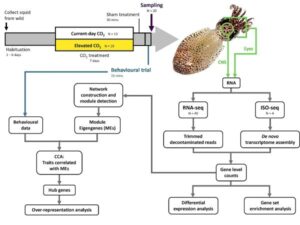BMC Ecology and Evolution – Diuqin lechiguanae gen. et sp. nov., a new unenlagiine (Theropoda: Paraves) from the Bajo de la Carpa Formation (Neuquén Group, Upper Cretaceous) of Neuquén Province, Patagonia, Argentina

Unenlagiine theropods are a group of dinosaurs that are key to understanding how living birds evolved. However, fossils of these dinosaurs are rare, especially from the Late Cretaceous period. Therefore, it has been rather challenging to piece together their evolutionary history and understand the modifications that occurred within the Unenlagiinaen lineage over time.
A recent paper published in BMC Ecology and Evolution describes the discovery of Diuqin lechiguanae gen. et sp. nov., a new unenlagiine theropod dinosaur from the Upper Cretaceous (Santonian) Bajo de la Carpa Formation in Neuquén Province, Argentina. This new taxon, described from an incomplete postcranial skeleton, exhibits unique morphological features, particularly in the humerus, which appears intermediate between older and younger unenlagiines. Phylogenetic analysis places Diuqin within Paraves, with a strong affinity to Unenlagiinae. Interestingly, the humerus bears tooth marks, likely from a crocodyliform, mammal, or another theropod, which offers additional insights into the paleoecology of these theropods and their interactions with other animal species of their time. This finding marks a significant advancement in the field of paleontology, bridging a 15-million-year gap in the unenlagiine fossil record.
BMC Medical Genomics – Exploring the potential of genetic analysis in historical blood spots for patients with iodine-deficient goiter and thyroid carcinomas in Switzerland and Germany (1929–1989)

Iodine is crucial for producing thyroid hormones and maintaining thyroid gland health, with deficiencies leading to goiter and severe developmental issues, including growth and mental impairments. Historically, Switzerland faced significant iodine deficiency, causing high rates of goiter and cretinism until iodine fortification of salt began in the early 20th century. Despite the success of these programs in reducing goiter prevalence, some cases remain, emphasizing the need to explore additional factors, including genetic predispositions.
To examine the genetic factors contributing to goiter development, despite adequate iodine supplementation, a recent study published in BMC Medical Genomics assessed the feasibility of extracting and analyzing DNA from historical blood spots found in medical records of patients with iodine deficiency-induced goiter and thyroid cancer between 1929 and 1989 in Switzerland. The researchers found that DNA yields varied significantly between samples, with many showing substantial degradation and mixtures of DNA from different contributors. The study concludes that each sample must be individually evaluated for genetic analysis, and larger or entire blood ablations should be collected to mitigate insufficient DNA quantities.
The impact of this advance is significant for historical epidemiology and genetic research, as it allows for the exploration of genetic predispositions in populations from past decades, potentially leading to a better understanding of disease causes and the development of targeted interventions.
BMC Environmental Science – Is “green” ammonia a misnomer? Unpacking the green label from a food-water-energy nexus perspective in water-scarce regions
 The production of conventional fertilizers, such as ammonium nitrate, significantly contributes to greenhouse gas emissions and environmental degradation due to energy-intensive processes and the release of nitrous oxide. In contrast, green ammonia production, which uses renewable energy sources for hydrogen generation, tries to reduce carbon footprints and environmental impact, thereby offering a more sustainable alternative to traditional methods.
The production of conventional fertilizers, such as ammonium nitrate, significantly contributes to greenhouse gas emissions and environmental degradation due to energy-intensive processes and the release of nitrous oxide. In contrast, green ammonia production, which uses renewable energy sources for hydrogen generation, tries to reduce carbon footprints and environmental impact, thereby offering a more sustainable alternative to traditional methods.
A recent Comment article published in BMC Environmental Science, takes a close look at the term “green ammonia,” especially in areas with limited water resources. The authors point out that while green ammonia is produced using green hydrogen (which comes from water split using renewable energy) and does cut down on carbon emissions, it still has other serious environmental effects. These include a high demand for fresh water and potential ecological harm from desalination.
The authors argue that the fertiliser industry should use a wider perspective on environmental impact, focusing not only on carbon emissions but also on reducing the flow of reactive nitrogen and phosphorus. They suggest that recycling human waste and other organic materials could be a better and more sustainable option than green ammonia. This approach could greatly cut down on carbon emissions and nutrient pollution.
BMC Genomics – Transcriptomic responses in the nervous system and correlated behavioural changes of a cephalopod exposed to ocean acidification

Ocean acidification, caused by increased CO2 levels, which leads to higher concentrations of carbonic acid in seawater, significant effects the marine ecosystem. As we are facing increasingly adverse climatic parameters, understanding how animals respond to future environmental conditions is crucial for predicting their adaptability and survival.
In a recent study published in BMC Genomics, Thomas et al. investigated the neurobiological effects of ocean acidification (OA) on the two-toned pygmy squid (Idiosepius pygmaeus). By using a de novo transcriptome assembly approach, the authors assessed transcriptomic alterations in the squid’s central nervous system (CNS) and eyes under elevated CO2 conditions and correlated molecular changes with varying CO2 levels and behavioral modifications.
Their findings indicate that OA triggers transcriptomic responses related to neurotransmission, neuroplasticity, immune function, and oxidative stress. These molecular changes were also associated with changes in behavior (e.g. increased activity levels and changes in visually guided interactions), suggesting a mechanistic link between environmental changes and behavioral responses.
BMC Digital Health – Potential for use of tetris in the neonatal unit – a scoping review
 Post-traumatic stress symptoms (PTSS) significantly affect the daily lives and relationships of those affected, especially preterm parents in the stressful environment of Neonatal Units (NNUs). Tetris, a popular computer game, may offer a novel method for reducing PTSS by minimizing intrusive memories associated with trauma. This review aims to evaluate the potential of Tetris as an intervention for preterm parents, exploring its feasibility and effectiveness in mitigating PTSS within this vulnerable population.
Post-traumatic stress symptoms (PTSS) significantly affect the daily lives and relationships of those affected, especially preterm parents in the stressful environment of Neonatal Units (NNUs). Tetris, a popular computer game, may offer a novel method for reducing PTSS by minimizing intrusive memories associated with trauma. This review aims to evaluate the potential of Tetris as an intervention for preterm parents, exploring its feasibility and effectiveness in mitigating PTSS within this vulnerable population.
A study published in BMC Digital Health investigated the potential application of the computer game “Tetris” as an initial intervention to alleviate post-traumatic stress symptoms (PTSS) in parents of preterm infants within Neonatal Units (NNUs). In their scoping review of 13 relevant articles, Craig et al. identified four recurring themes: memory consolidation, the impact of Tetris on intrusive memories (IMs), its neurological effects, and its feasibility in clinical trials.
The review shows that playing Tetris can interfere with the consolidation of traumatic memories, thereby reducing the frequency and intensity of disturbing memories. Additionally, the game is deemed both acceptable and feasible for clinical implementation, suggesting it could serve as a beneficial tool for preterm parents in mitigating PTSS.
Comments